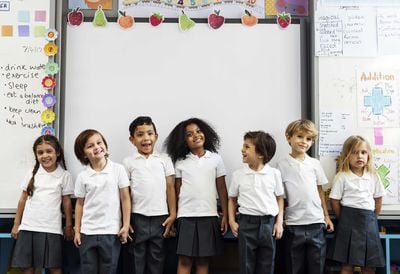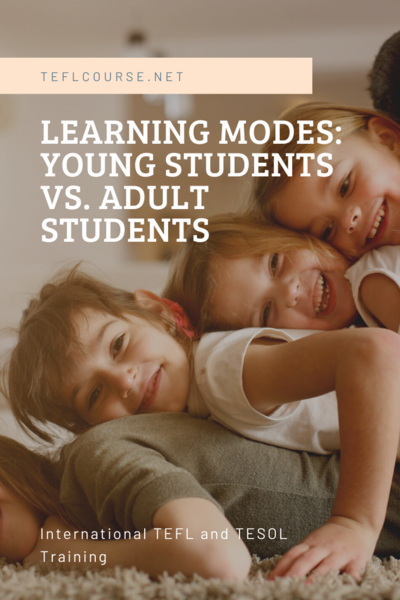Learning Modes: Young Students vs. Adult Students

In the past, the emphasis on teaching a foreign language was, amongst other older techniques, Grammar-Translation, and is still used in some situation today. This method helped the student to learn 'about' the language instead of learning the language (ITTT Unit 3,3). Over time, and continuing today, more and more attention and research have been placed on the question of what makes a good language learner.
Table of Contents
Differences between youngsters and adults
Differences between learning 1st and 2nd language
Approaches to teaching young students
Do you want to teach English abroad? Take a TEFL course!
This post was written by our TEFL certification graduate Cliff G. Please note that this blog post might not necessarily represent the beliefs or opinions of ITTT.
Differences between youngsters and adults
There are considerable differences in age, gender, motivation, attitude, and culture. Different students assimilate differently. The environment also plays a roll in learning. Some learn more effectively in groups and some in an individual setting. Even further, there are types of learners that learn though means that are individual or group-oriented. Learning styles and preferences vary from one individual to another (Tuan 1). There are visual learners, auditory learners, and kinesthetic learners. Some students can learn better from just sitting and listening to lectures while others require something visual like pictures and associations. Even some of these types of learners can learn in a compounding manner by adding an experiential component and applying "hands-on" (kinesthetic) or "real-life situation" learning.

Also Read: Benefits You Can Get if You Obtain a TEFL Certificate
Differences between learning 1st and 2nd language
There are many different learning aspects, situations, and applications in the arena/world of learning English as a Foreign Language (here forth referred to as "EFL") and learning English as a Second Language (here forth referred to as "ESL"). The Engage-Study-Activate (ESA) method has become the predominately internationally accepted method as it helps students of any age best learn a foreign language. This method was put forth by Jeremy Harmer and helps to expose the student to as much of the language as possible and then use the language as much as possible in the classroom (ITTT Unit3,5). Although this teaching method can be used with young or adult students, there are considerable factors to account for when teaching a young or adult student.
Levels of expertise
Young (under 18 years of age) or adult (over 18 years of age) student can be a beginner to advance. Whatever learning level the young or adult student is at-will only helps to determine the teaching level that needs to be implemented. There are some similarities in the difference between young and adult learners yet there are very predominant differences in the learning styles/modes. Young learners have many different requirements than adult learners, generally speaking. Within each group, there will be individual, or personality, differences. I general, the two groups will require the teacher to approach teaching EFL differently concerning each group.
Also Read: How much can I earn teaching English in Vietnam?
Approaches to teaching young students
There are different styles and approaches when teaching young learners. Rhyming and songs combined with real-life situations and physical movement can be effectively used with younger learners rather than with adult learners. The teacher needs to apply various techniques and activities in the classroom to keep young learners interested and focused (Ismail). Young learners can adapt, learn and absorb/retain language information very well. A teacher of young learners can employ a variety of modes to a young learner class, concerning the age and language level of the young learner. Teachers can use diagrams, posters, 3D objects, as well as other visual aids (ITTT(1)).
Teachers can use toys and cartoon drawings to make a lesson interactive, entertaining, and interesting for children to help them stay engaged throughout the lesson. The children must have fun. These methods mentioned above will engage children in multiple learning modes. Mentally the children will stay stimulated and engaged in a classroom lesson and will be able to absorb and retain the majority of the lesson. In a classroom with multiple young learners, there will be all types of personal learning modes. The teachers' privilege is to engage the visual, auditory, and kinesthetic learning modes and integrate speaking and reading.
"According to Knowles (1970, 1976, 1980), adult learners are self-directed and independent, and they can draw on a reservoir of accumulated experience as a rich resource in learning, are aware of their learning needs and want to apply skills and knowledge to real-life problems and tasks" (Tuan 17). This statement could represent the biggest difference in the learning modes of adult EFL learners. Adults are self-motivated and autonomous by their purpose for learning a second language. Adults, like children, have different learning styles and preferences within the visual, auditory, and kinesthetic styles. The teacher can approach teaching adults differently due to the difference previously mentioned. "It is possible (and beneficial) to let adults work things out for themselves, organize themselves and even decide the direction of the lessons" (TEFL Academy).

Also Read: What are the start up costs for teaching English abroad?
Approaches to teaching adults
Adults are also more able to engage in tasks related to the material and go deeper into aspects of specific areas of the language being taught. Discipline is an obvious style difference between young and adult learners. Adults can stay focused on the lesson/material longer so the teacher can engage the students more cognitively/mentally (TEFL Academy). Lectures and in-depth explanations are a teaching model that a teacher can use. Adults can engage with each other during the activate stage of a lesson and help teach each other. Teachers can help adult students capitalize on their autonomous nature. A 2013 study found that of all the different learning styles, adult students preferred the computer-assisted style the most with the auditory learning mode being a close second and visual styles being preferred the least (Tai 5-7).
Do you want to teach English abroad? Take a TEFL course!
There are basic learning styles amongst all ESL learners: visual, auditory, and kinesthetic being the predominant learning modes. Within these modes/styles are numerous variables. The vast differences between young and adult learners are the biggest factors that a teacher has to consider when teaching these segments. Each group requires a different approach and consideration. The ultimate goal is for the student to learn English. The teacher has the task of applying different styles to teaching and accomplishes the student's goal in the most efficient and productive way possible.
Apply now & get certified to teach english abroad!
Speak with an ITTT advisor today to put together your personal plan for teaching English abroad.
Send us an email or call us toll-free at 1-800-490-0531 to speak with an ITTT advisor today.
Related Articles:
- How to Legally Teach English in France With a Student Visa
- How to Legally Teach English in Spain with a Student Visa
- How to Legally Teach English in Italy with a Student Visa
- Top 10 Cities in Europe with the Highest Demand for English Language Teachers
- The 7 Biggest Myths About Teaching Abroad Alone as a Woman
- 7 Misconceptions about TEFL Uncovered




